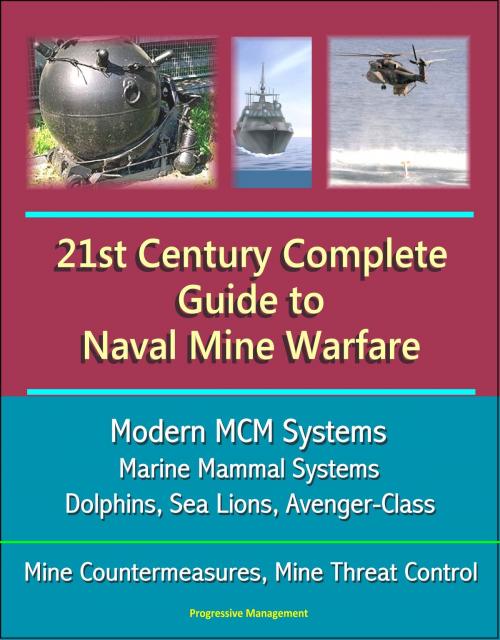21st Century Complete Guide to Naval Mine Warfare: Modern MCM Systems, Marine Mammal Systems, Dolphins, Sea Lions, Avenger-Class, Mine Countermeasures, Mine Threat Control
Nonfiction, History, Military, Naval| Author: | Progressive Management | ISBN: | 9781310414008 |
| Publisher: | Progressive Management | Publication: | April 24, 2014 |
| Imprint: | Smashwords Edition | Language: | English |
| Author: | Progressive Management |
| ISBN: | 9781310414008 |
| Publisher: | Progressive Management |
| Publication: | April 24, 2014 |
| Imprint: | Smashwords Edition |
| Language: | English |
Seven unique U.S. Navy documents provide a thorough guide to naval mine warfare, with information on modern mine countermeasures (MCM), marine mammal systems, the use of dolphins and sea lions, organic MCM, Avenger class, SQQ-32 Sonar, SLQ-37, SLQ-38, SLQ-48(V), MH-53E Sea Dragon Helicopters, explosive ordnance disposal, littoral combat ship (LCS), methods of actuation, USMC Shallow Water Mine Countermeasures, and much more.
The History of the Sea Mine and its Continued Importance in Today's Navy - David Bushnell has become known as the father of mine warfare. As a student at Yale University, he worked on the development of underwater explosives. In his research, he discovered that gunpowder could be exploded underwater. During the American Revolution Bushnell was authorized to design a sea mine (usually referred to as a "torpedo" by Bushnell) to be used against the British fleet.
21st Century U.S. Navy Mine Warfare - Ensuring Global Access and Commerce - In February 1991 the Navy lost command of the sea—the North Arabian Gulf— to more than a thousand mines that had been sown by Iraqi forces. Mines severely damaged two Navy warships, and commanders aborted an amphibious assault for fear of even more casualties. Spurred on by this experience, the Navy has taken consistent, aggressive and focused action to ensure that it is prepared for all future mine "events."
Solving the Mine Countermeasures Problem: A Matter of Focus and Priority - This document reviews mine countermeasure operations and how they impact on current national security and national military strategies as well as service doctrine.
Shallow-Water Mine Countermeasure Capability for USMC Ground Reconnaissance Assets - As the Marine Corps looks to the future with its concept of expeditionary maneuver warfare (EMW), shallow-water mines remain a "show-stopper" to the Corps' forcible entry requirement. With limited Naval assets available, MAGTF commanders are still dependent on Marine ground reconnaissance assets for amphibious reconnaissance of potential beach landing sites -- to include the detection of shallow-water mines.
The Operational Effects of Mine Warfare - This paper demonstrates that naval mines are a threat to the operational commander and that there are actions he can take to reduce the operational effects of mine warfare. The first section demonstrates that mine warfare is a pertinent problem for the operational commander by examining three principle relationships.
Sweeping Changes for Mine Warfare: Controlling the Mine Threat - This report proposes that the U.S. Navy deter and, if necessary, combat potential minelayers by pursuing a "pro-active" offensive mine warfare strategy. Central to this proposed strategy is the development, acquisition, and use of Remote Controlled (RECO) mines. It is argued that, given the historical problems the United States has had in the area of naval mine warfare, a strategy aimed at the aggressive deterrence of enemy mine laying be embraced so as to project forces ashore in future amphibious operations.
Inadequate Mine Countermeasure Systems and Capabilities for Future Amphibious Operations - When a one-thousand-dollar mine can severely damage a one-billion-dollar ship...it is time to do something about it (Edney). The significance of mines to naval operations has been recognized in modern warfare. For example, during the Korean War the Chief of Naval Operations, Admiral Forrest P. Sherman observed before an amphibious assault on Wonsan: When you can't go where you want to, when you want to, you haven't got command of the sea. And command of the sea is a rock-bottom foundation for all our war plans. We've been very submarine-conscious and air-conscious. Now we're getting mine-conscious.
Seven unique U.S. Navy documents provide a thorough guide to naval mine warfare, with information on modern mine countermeasures (MCM), marine mammal systems, the use of dolphins and sea lions, organic MCM, Avenger class, SQQ-32 Sonar, SLQ-37, SLQ-38, SLQ-48(V), MH-53E Sea Dragon Helicopters, explosive ordnance disposal, littoral combat ship (LCS), methods of actuation, USMC Shallow Water Mine Countermeasures, and much more.
The History of the Sea Mine and its Continued Importance in Today's Navy - David Bushnell has become known as the father of mine warfare. As a student at Yale University, he worked on the development of underwater explosives. In his research, he discovered that gunpowder could be exploded underwater. During the American Revolution Bushnell was authorized to design a sea mine (usually referred to as a "torpedo" by Bushnell) to be used against the British fleet.
21st Century U.S. Navy Mine Warfare - Ensuring Global Access and Commerce - In February 1991 the Navy lost command of the sea—the North Arabian Gulf— to more than a thousand mines that had been sown by Iraqi forces. Mines severely damaged two Navy warships, and commanders aborted an amphibious assault for fear of even more casualties. Spurred on by this experience, the Navy has taken consistent, aggressive and focused action to ensure that it is prepared for all future mine "events."
Solving the Mine Countermeasures Problem: A Matter of Focus and Priority - This document reviews mine countermeasure operations and how they impact on current national security and national military strategies as well as service doctrine.
Shallow-Water Mine Countermeasure Capability for USMC Ground Reconnaissance Assets - As the Marine Corps looks to the future with its concept of expeditionary maneuver warfare (EMW), shallow-water mines remain a "show-stopper" to the Corps' forcible entry requirement. With limited Naval assets available, MAGTF commanders are still dependent on Marine ground reconnaissance assets for amphibious reconnaissance of potential beach landing sites -- to include the detection of shallow-water mines.
The Operational Effects of Mine Warfare - This paper demonstrates that naval mines are a threat to the operational commander and that there are actions he can take to reduce the operational effects of mine warfare. The first section demonstrates that mine warfare is a pertinent problem for the operational commander by examining three principle relationships.
Sweeping Changes for Mine Warfare: Controlling the Mine Threat - This report proposes that the U.S. Navy deter and, if necessary, combat potential minelayers by pursuing a "pro-active" offensive mine warfare strategy. Central to this proposed strategy is the development, acquisition, and use of Remote Controlled (RECO) mines. It is argued that, given the historical problems the United States has had in the area of naval mine warfare, a strategy aimed at the aggressive deterrence of enemy mine laying be embraced so as to project forces ashore in future amphibious operations.
Inadequate Mine Countermeasure Systems and Capabilities for Future Amphibious Operations - When a one-thousand-dollar mine can severely damage a one-billion-dollar ship...it is time to do something about it (Edney). The significance of mines to naval operations has been recognized in modern warfare. For example, during the Korean War the Chief of Naval Operations, Admiral Forrest P. Sherman observed before an amphibious assault on Wonsan: When you can't go where you want to, when you want to, you haven't got command of the sea. And command of the sea is a rock-bottom foundation for all our war plans. We've been very submarine-conscious and air-conscious. Now we're getting mine-conscious.















